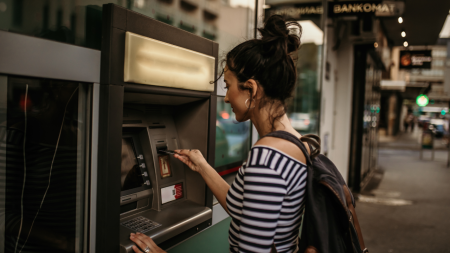Images by Getty Images; Illustration by Issiah Davis/Bankrate
Key takeaways
- You’ll need necessary documents — including a government-issued ID, social security number, and proof of address — to open an account.
- If you’re denied because of your banking history, there are banks and financial technology companies that offer second-chance accounts.
A savings account is a safe place to keep your emergency fund or set aside money for short-term financial goals. These accounts are offered by almost every bank and credit union in the U.S., and they can help you grow your savings through the interest they pay.
Summary of how to open a savings account:
- Shop around for accounts with high yields and low fees.
- Gather required documents like your ID, Social Security number, and proof of address.
- Decide between an individual or joint account based on your needs.
- Submit your application online or in person.
- Make your first deposit
Your savings account should mesh with your priorities and goals, says Mary Hines Droesch, Head of Products for Consumer and Small Business Products at Bank of America. “Whether you’re saving for a home, education, a car, vacations, or an emergency fund. For example, if you’re working to build a savings habit, consider an account that automates the process for you,” said Droesch.
Opening a savings account: Step-by-step
It’s relatively easy to open a savings account at most banks and credit unions, although it usually takes several steps.
1. Choose the right savings account for you
Before you open your account, make sure you’ve chosen the right bank for your needs. Key features when making your choice may include:
Some banks offer multiple savings accounts. If you’re considering a bank that offers more than one option, compare them using the criteria above, and look out for any distinguishing features unique to each account.
2. Gather required documents
When you open any bank account, you’ll need to provide some information about yourself, as well as some documents. Make sure you — and any joint account owners — have the following information ready when you open the account in person or online:
- Government-issued identification, such as a driver’s license or passport
- Social Security number
- Date of birth
- Address (and proof of address, if your ID lists a previous address)
- Contact information
- Bank account information to fund your new account, if applicable
3. Choose a joint or individual account
Open an individual account if you want a savings account just for yourself. A joint account is an account owned with another person, such as your spouse or your child.
Joint accounts offer some benefits:
- They make it easier for your spouse or child to access funds that are shared.
- The presence of a joint owner can provide a higher level of FDIC insurance (up to $500,000 instead of $250,000, since each person has $250,000 worth of deposit insurance in the joint account ownership category).
4. Complete the application
Complete your application with all the required information and wait for the bank to approve your account. This usually happens quickly, within one or two business days. The bank will notify you once your account has been created, or if your application has been denied.
5. Fund your account
You may need to make an initial deposit when starting up a savings account. You can usually fund the account with cash or a check, if you’re opening the account in person. To deposit money electronically, you can often make a mobile check deposit or transfer funds from a linked account.
Deposit enough money to avoid potential fees
Some savings accounts charge a monthly maintenance fee that can eat away at your savings. Most banks offer ways to waive the fee, though, including by having a certain minimum balance in the account. Make sure you always keep a sufficient balance in your account to avoid paying a fee.
Why you may want to add a beneficiary
A beneficiary is the person who will receive the money in your deposit accounts upon your death. It’s important to name a beneficiary as it ensures your money will end up where you intend.
The same goes for joint deposit accounts. Although the surviving account holder will receive sole ownership of the account when you die, you’ll still want to name a beneficiary in the event both joint owners pass away.
How to make a savings game plan
Albeit a big first step, opening a savings account is only the beginning of your savings journey. To make the most of your account, you’ll want to set up a savings plan. A couple of tips that may help you get started include:
- Choosing a specific saving goal
- Setting a budget and savings deadline
- Creating a different account for each savings goal
- Automating your savings by setting up monthly or bi-weekly automatic transfers from your checking account into your savings account
Your choice of savings account — and bank — can depend upon your reason for saving money
If you want to build an emergency fund that you can access at a moment’s notice, opening an account with a bank where you also have a checking account could make sense. Some banks also offer higher APYs, often called relationship rates, for maintaining multiple accounts at the same bank.
If you’re saving for a specific goal — such as a car or a down payment on a home — and don’t need easy access to the funds, it can make more sense to shop around for the best rates, which might be found at an online bank. Though ideally, your emergency fund is also in a high-yield savings account so your funds can grow quicker.
See more: Bankrate’s picks for the best checking accounts
How to choose the best savings account
Here are some features to look for when choosing a savings account.
- High APY: The higher the APY, the faster your savings will grow. Keep in mind that APYs on savings accounts are typically variable, which means the rate can change at any time.
Do the math to see how much interest you can earn
If you deposit $10,000 into a savings account at a bank that pays 0.01 percent APY, you’ll earn $1 in interest at the end of one year. Alternatively, if you choose an account elsewhere that offers 4 percent APY, you’d earn $400 in interest in one year. (This assumes the APY stayed the same for a year and you didn’t make any additional deposits or withdraw any money.)
- No monthly fees: Some banks charge a monthly maintenance fee unless you meet certain requirements. If you end up paying the fees, that could eat into your savings significantly.
Money tip:
Let’s say you have $500 in a savings account that charges a $5 monthly fee and pays a 4 percent APY. In a year, you’d earn $20 in interest…but you could end up paying $60 in monthly fees. So you might actually lose $40. Look for an account with no monthly fee or one you can easily avoid so you don’t have to worry about such charges eating away at your balance.
- FDIC or NCUA insurance: It’s important to consider banks and credit unions that are insured up to the limit allowed by law. For banks, these will be accounts insured by the FDIC. For credit unions, these will be accounts insured by the NCUA.
What to do if you can’t open a savings account
Many banks use ChexSystems, a consumer reporting agency, when making approval decisions. If your bank uses ChexSystems, and you’re denied an account, you can request a disclosure report to find out why. You can also dispute any errors you find that may be negatively impacting your report.
If your banking history is preventing you from opening a savings account, you can look for a bank that offers second-chance checking accounts. While not the same as a savings account, second-chance accounts are more widely accessible. These accounts often come with standard checking account features, such as ATM access, bill pay and mobile banking. Usually, if you can keep your account in good standing for a period of time — often 12 months — you’ll be able to upgrade to a standard checking or savings account.
Banks and financial technology (fintech) companies that offer second chance accounts include Wells Fargo, Varo Bank and Chime.
Bottom line
Savings accounts are valuable tools for people who want to set aside money for a goal or an emergency fund. Consider all of your options, including local banks and online banks, and look for the account that offers the best interest rates at the lowest cost. Taking the time to do some comparison shopping can help you get the most out of your money.
FAQs
Why we ask for feedback
Your feedback helps us improve our content and services. It takes less than a minute to
complete.
Your responses are anonymous and will only be used for improving our website.
Help us improve our content
Read the full article here












